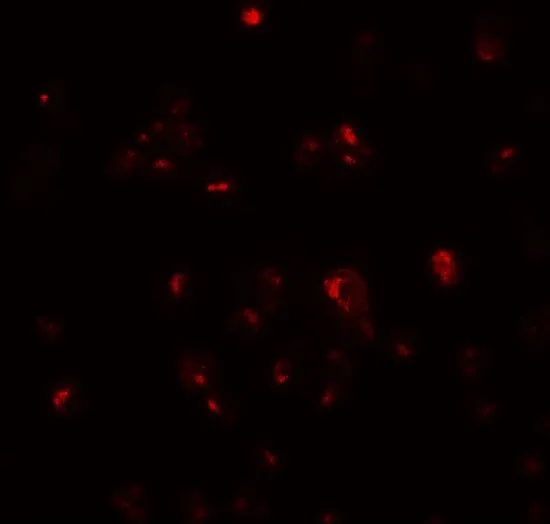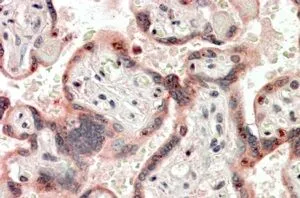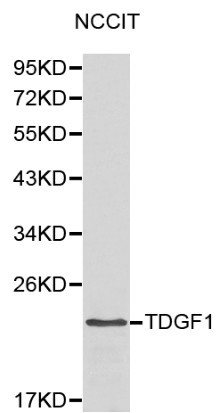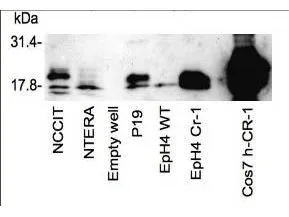
Western blot using GeneTexs affinity purified anti-Cripto-1 antibody shows detection of endogenous and transfected Cripto-1 from mouse and human sources. The Cripto-1 band appears above the 17.8 kDa marker. Endogenous detection is shown using mouse P19 embryonal carcinoma cells and human NCCIT testicular embryonal carcinoma cells. EpH4 CR-1 is a mouse mammary epithelial cell line stably expressing mouse Cripto-1. NTERA cells are human embryonal carcinoma cells that, when overgrown, differentiate and lose Cripto-1 expression. COS7 cells transfected with human Cripto-1 expression vector were used as a positive control and EpH4 WT cells were used as a negative control. A non-specific band at 45kDa may be present in some preparations. The primary antibody was used at a 1:500 dilution.
Cripto antibody
GTX48477
ApplicationsWestern Blot, ELISA, ImmunoHistoChemistry, ImmunoHistoChemistry Paraffin
Product group Antibodies
TargetCRIPTO
Overview
- SupplierGeneTex
- Product NameCripto antibody
- Delivery Days Customer9
- Application Supplier NoteWB: 1:1000. ELISA: 1:105000. *Optimal dilutions/concentrations should be determined by the researcher.Not tested in other applications.
- ApplicationsWestern Blot, ELISA, ImmunoHistoChemistry, ImmunoHistoChemistry Paraffin
- CertificationResearch Use Only
- ClonalityPolyclonal
- Concentration0.97 mg/ml
- ConjugateUnconjugated
- Gene ID6997
- Target nameCRIPTO
- Target descriptioncripto, EGF-CFC family member
- Target synonymsCR, CR-1, CRGF, TDGF1, protein Cripto, cripto-1 growth factor, epidermal growth factor-like cripto protein CR1, teratocarcinoma-derived growth factor 1
- HostRabbit
- IsotypeIgG
- Protein IDP13385
- Protein NameTeratocarcinoma-derived growth factor 1
- Scientific DescriptionHuman Cripto-1 (CR-1), also known as Teratocarcinoma-derived growth factor 1 (TDGF1), is a member of the epidermal growth factor (EGF)-GFC family and has been implicated in both embryogenesis and carcinogenesis. During early vertebrate development, CR-1 functions as a co-receptor for Nodal, a transforming growth factor b (TGFb) family member, and is essential for mesoderm and endoderm formation and anterior-posterior and left-right axis establishment. In adult tissues, CR-1 is expressed at a low level in all stages of mammary gland development, and expression increases during pregnancy and lactation. Over-expression of CR-1 in mouse mammary epithelial cells leads to their transformation in vitro, and when injected in mammary glands, CR-1 produces ductal hyperplasias.
- Storage Instruction-20°C or -80°C,2°C to 8°C
- UNSPSC12352203

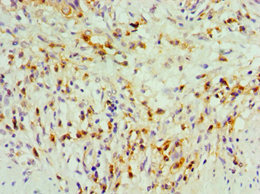
![WB analysis of HEK293 (1) and Cripto (AA: 31-188) human IgG Fc transfected HEK293 (2) cell lysate using GTX31125 Cripto antibody [3A6].](https://www.genetex.com/upload/website/prouct_img/normal/GTX31125/GTX31125_1847_WB_w_23060722_588.webp)
